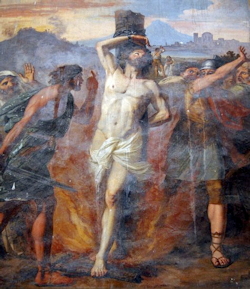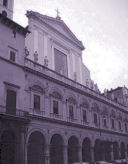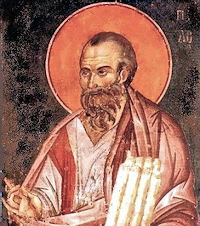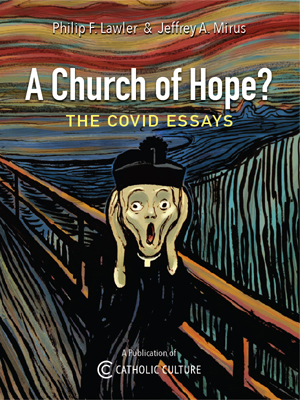Lent: February 23rd
Friday of the First Week of Lent; Optional Memorial of St. Polycarp; Ember Friday
» Enjoy our Liturgical Seasons series of e-books!
Today is the Optional Memorial of St. Polycarp of Smyrna (69-155), who was converted to Christianity by St. John the Evangelist. He was a disciple of the apostles and friend of St. Ignatius of Antioch. He was ordained bishop of Smyrna (now Izmir, Turkey) and was about eighty-six when the Roman pro-consul urged him to renounce Christ and save his life. St. Polycarp said, "For eighty-six years I have served Him and he has never wronged me. How can I renounce the King who has saved me?" He suffered martyrdom in 155 by burning at the stake in the amphitheater of Smyrna.
Today is Ember Friday of the Lent or Spring Ember Days. There are two principal objects for the Ember Days of this period of the year: the first is to publicly offer thanks to God the season of Spring, and secondly to ask God to bless the fruits of the earth and human labor. A third traditional focus of the Ember Days is to ask Him to enrich with His choicest graces the priests and sacred ministers particularly those who might be ordained on this day. See Contemporary Observation of Ember Days and Lenten Ember Days for more information.
Meditation on the Liturgy—Ember Friday in Spring
The need to make reparation is a vital, inescapable urge of a free person. His very nature cries out for order and peace. His reason tells him that where an order has been violated, the order must be repaired; and the higher the order, the greater must be the reparation. To be free at all, is to accept the responsibility for atonement. Is is a violation of God's order. Sin demands reparation—the reparation of personal penance, personal prayer, personal charity to all. Part of our atonement to God is made by serving our fellow men.
—Maryknoll Missal
Meditation—Lent, a Great Spiritual Retreat
As he places the Ashes on the person's forehead the celebrant says "Remember you are dust, and to dust you shall return" (cf. Gn 3: 19), or he repeats Jesus' exhortation, "Repent, and believe in the Gospel" (cf. Mk 1: 15). Both formulas are a reminder of the truth about human life: we are limited creatures, sinners always in need of repentance and conversion. How important it is to listen to and accept this reminder in our time! When contemporary man proclaims his total autonomy from God, he enslaves himself and often finds himself in comfortless loneliness. The invitation to conversion, therefore, is an incentive to return to the embrace of God, the tender and merciful Father, to entrust oneself to him, to entrust oneself to him as adoptive sons, regenerated by his love. With wise pedagogy the Church repeats that conversion is first and foremost a grace, a gift that opens the heart to God's infinite goodness. He himself anticipates with his grace our desire for conversion and accompanies our efforts for full adherence to his saving will. Therefore, to convert is to let oneself be won over by Jesus (cf. Phil 3: 12) and "to return" with him to the Father. . . . ( more)
—Pope Benedict XVI
Things to Do:
- Today's reading from the book of Isaiah declares that the fasting desired by the Lord is not so much denying oneself food (although this is important) but rather, consists in "Sharing your bread with the hungry, sheltering the oppressed and the homeless; / Clothing the naked when you see them, and not turning your back on your own." Many families take these words to heart by having an inexpensive, penitential dinner on Fridays in Lent (such as beans and rice) and then giving the extra money to the poor.
- Many families give each child one pretzel during Friday dinners in Lent. Remind your children of the spiritual significance of the pretzel.
- Pray the Stations of the Cross today with your family. An excellent version with beautiful meditations composed by our Holy Father is his Stations of the Cross at the Colosseum. Some other recommended versions are: Eucharistic Stations of the Cross, and the more traditional Stations of the Cross written by Saint Alphonsus Liguori can be found in most Catholic bookstores. Here are some guidelines for praying the Stations of the Cross in your home.
- Any of the linked activities (Fun Pretzel Project, Lenten Scrapbook, Candelabrum for Stations of the Cross) are a wonderful way for your children to spend their Friday afternoons throughout this season of Lent.
Saint Polycarp of Smyrna
 Polycarp had known those who had known Jesus, and was a disciple of St. John the Apostle, who had converted him around the year 80 AD. He taught, says his own pupil Irenaeus of Lyons, the things that he learned from the Apostles, which the Church hands down, which are true. Irenaeus, who as a young boy knew Polycarp, praised his gravity, holiness, and majesty of countenance. He had lived near Jerusalem and was proud of his early associations with the Apostles.
Polycarp had known those who had known Jesus, and was a disciple of St. John the Apostle, who had converted him around the year 80 AD. He taught, says his own pupil Irenaeus of Lyons, the things that he learned from the Apostles, which the Church hands down, which are true. Irenaeus, who as a young boy knew Polycarp, praised his gravity, holiness, and majesty of countenance. He had lived near Jerusalem and was proud of his early associations with the Apostles.
Polycarp became bishop of Smyrna and held the see for about 70 years. He was a staunch defender of orthodoxy and an energetic opponent of heresy, especially Marcionism and Valentinianism (the most influential of the Gnostic sects). Toward the end of his life he visited Pope St. Anicetus in Rome and, when they could not agree on a date for Easter, decided each would observe his own date. To testify his respect and ensure that the bonds of charity were unbroken, Anicetus invited Polycarp to celebrate the Eucharist in the papal chapel on this occasion. Polycarp suffered martyrdom with 12 others of his flock around the year 156.
—Excerpted from St. Polycarp, Bishop and Martyr by Fr. Paul Haffner (Inside the Vatican, February 2004)
Among the select few from apostolic times about whom we have some historical information is Polycarp, bishop of Smyrna and one of the most glorious martyrs of Christian antiquity. His life and death are attested by the authentic "Acts" of his martyrdom (no similar account is older), as well as by other contemporary writings. It moves us deeply when, for example, we find in St. Irenaeus, a disciple of Polycarp, the passage in which he reminisces:
"The memory of that time when as a youth I was with Polycarp in Asia Minor is as fresh in my mind as the present. Even now I could point to the place where he sat and taught, and describe his coming and going, his every action, his outward appearance, and his manner of discourse to the people. It seems as though I still heard him tell of his association with the apostle John and with others who saw the Lord, and as though he were still relating to me their words and what he heard from them about the Lord and His miracles. . . ."
On the day of his death (February 23) the Martyrology recounts with deep reverence:
"At Smyrna, the death of St. Polycarp. He was a disciple of the holy apostle John, who consecrated him bishop of that city; and there he acted as the primate of all Asia Minor. Later, under Marcus Antoninus and Lucius Aurelius Commodus, he was brought before the tribunal of the proconsul; and when all the people in the amphitheater cried out against him, he was handed over to be burned to death. But since the fire caused him no harm, he was put to death by the sword. Thus he gained the crown of martyrdom. With him, twelve other Christians, who came from Philadelphia, met death by martyrdom in the same city."
—Excerpted from The Church's Year of Grace, Pius Parsch.
Patronage: Against earache; against dysentery
Symbols and Representation: Wearing the pallium, holding a book representing his Epistle to the Philippians
Highlights and Things to Do:
- Listen to the Catholic Culture podcasts on St. Polycarp and his writings:
- Read more about St. Polycarp:
- Read an account of his martyrdom.
- Read St. Polycarp's Epistle to the Philippians.
- St. Polycarp's relics are located in the Sant'Ambrogio della Massima (St. Ambrose) in Rome, set in a marble memorial stone under the main altar.
 Friday of the First Week of Lent, Ember Friday
Friday of the First Week of Lent, Ember Friday
Station with Santi Dodici Apostoli (The Twelve Holy Apostles, also Santi Apostoli):
Today's station is at the minor basilica of the Twelve Apostles. Traditionally, this is the place where the Romans choose their candidates for priesthood (Rite of Election). It was erected by Julius I (337-352) over the barracks of ancient Rome's firemen and entrusted since 1463 to the Conventual Franciscans. Originally dedicated to the Apostles St. James and St. Philip, it was rededicated to all the Apostles in the 16th century.
For more on Santi Dodici Apostoli, see:
For further information on the Station Churches, see The Stational Church.






